Remains of the Taiko Tower – First Tower
The Nishinomaru Garden area is filled with memories of Toyotomi Hideyoshi and his wife, Kita no Mandokoro. There are plenty of things to see, including the sturdy beauty of Osaka Castle’s oldest Sengan-yagura and Inui-yagura, the ingenious time management system inside the castle that remains at the remains of the Taiko-yagura, and the valuable gunpowder storehouse “Enshogura.” You can also enjoy a historical worship experience at Toyokuni Shrine, which enshrines Hideyoshi.
Remains of the Taiko Tower
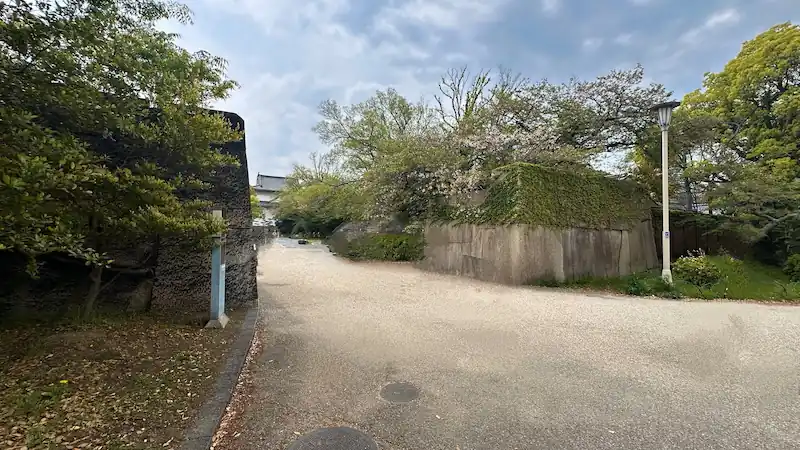
⭐ Recommendation Rating
- Historical Significance: ☆☆
- Visual Appeal: ☆☆
- Experiential Value: ☆
🏛 Overview
The Taiko Yagura Ruins are located just north of the remains of the Minamishikirimon Gate, within the Ninomaru area of Osaka Castle. This structure once housed a drum on its second floor, used to signal the time across the castle grounds. It was a two-story turret-gate structure: the lower floor functioned as a gate, while the upper floor held the drum.
Built around 1628, the tower played a crucial role alongside the Minamishikirimon Gate in managing both security and timekeeping. The term Shikirimon refers to a dividing gate between the Honmaru (inner citadel) and Nishinomaru (western citadel), and the Taiko Yagura was vital in marking this administrative and defensive boundary.
Every day at noon, the “Shogo Taiko” (noon drum) was sounded, and its echo resounded through the castle. This daily ritual is said to have continued until the early Meiji period (1868), offering a glimpse into the rhythms of life within the castle.
| Year Built | Early 17th century (Edo period) |
|---|---|
| Builder | Tokugawa shogunate |
| Structure/Features | Drum turret (Taiko Yagura) situated above the South Gate (Minami Shikirimon), used for timekeeping and signaling |
| Renovation/Restoration | None; original structure destroyed |
| Current Status | Only the stone base remains; turret no longer exists |
| Destruction/Damage | Destroyed during the Boshin War (1868–1869) |
| Cultural Property Designation | Not designated |
| Remarks | Located near the South Gate; serves as a historical site within Osaka Castle Park |
🗺 Address:
1-1 Osaka Castle, Chuo-ku, Osaka City, Osaka Prefecture (Southwest of Ninomaru)
🚶 Access
: 2 minutes on foot (approx. 140m) from Tamon Yagura
⏳ Estimated time for sightseeing
: Short sightseeing spots: About 5 to 10 minutes
If you want to explore thoroughly: About 20 minutes (including the remains of the South Partition Gate and the west side of Ninomaru)
📍 Attractions
🔹 Traces of the Two-Story Gate: While the structure no longer stands, the remaining foundation and layout hint at its original size and purpose.
🔹 History of the Noon Drum: The sound once regulated daily life, from military routines to castle town activities.
🔹 Connection with Minamishikirimon Gate: As an integrated complex, the tower also served as a gatehouse and control point.
🔹 Seasonal Enjoyment: In spring, plum and cherry blossoms bloom near the quiet stone base—imagine the sound of the timekeeping drum echoing through a blossoming landscape.
📌 Trivia
🔹 Surprising historical background: The drum wasn’t just for timekeeping—it also served as an alarm system for fires and emergencies, functioning as part of the castle’s “sound-based security network.”
🔹 Little-known fact: The noon drumming custom persisted into the early Meiji era, even as Japan transitioned into a modern state.
🔹 Connection with historical figures: Samurai and domain lords used the drum’s sound to coordinate their daily schedules—making it a vital symbol of time in the castle’s operations.
Sengan Yagura
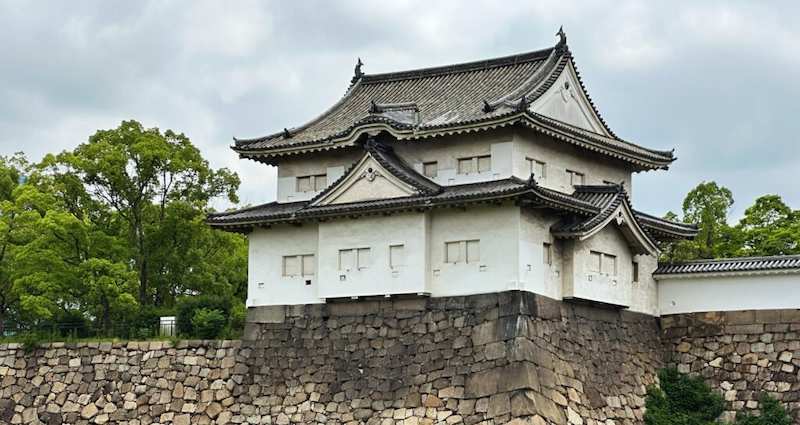
⭐ Recommendation Rating
- Historical Significance: ☆☆☆
- Visual Appeal: ☆☆☆
- Experiential Value: ☆☆☆
🏛 Overview
The Sengan Yagura is a two-story turret built in 1620 as part of the Tokugawa Shogunate’s reconstruction of Osaka Castle. Strategically located to protect the castle’s main entrance, this defensive stronghold features a striking contrast of white plaster walls and black tiled roofs, symbolizing both power and elegance. It is one of the oldest remaining structures within Osaka Castle.
The turret’s name comes from a famous anecdote: during Oda Nobunaga’s siege of Ishiyama Honganji Temple, he is said to have remarked about a nearby tower, “I want to take that—even if it costs me a thousand kanmon” (sengan). Though it was rebuilt during the Tokugawa period, the Sengan Yagura is believed to retain the spirit and design philosophy of Toyotomi-era architecture.
Surviving the great fires and wars, the structure was dismantled and restored in 1961, and remains in excellent condition today. Thanks to its historical significance and preservation, the Sengan Yagura is a key example of early Edo-period castle architecture.
| Year Built | 1620 (Edo period) |
|---|---|
| Builder | Kobori Enshū |
| Structure/Features | Two-story turret with lattice windows and iron plate openings for defense |
| Renovation/Restoration | Maintained in original condition; limited restorations over time |
| Current Status | Original structure; designated as an Important Cultural Property |
| Destruction/Damage | Survived multiple conflicts; remains intact |
| Cultural Property Designation | Important Cultural Property (Japan) |
| Remarks | Protected the northern approach to Otemon Gate; among the oldest surviving structures in Osaka Castle |
🗺 Address:
1-1 Osakajo, Chuo-ku, Osaka City, Osaka Prefecture
🚶 Access
3 minutes on foot (approx. 210m) from Remains of the Taiko Tower
⏳ Estimated tour
time: Short tour: About 15-20 minutes.
If you want to explore thoroughly: About 1 hour (also visit the nearby Tamon Yagura Tower and Otemon Gate)
📍 Attractions
🔹 Exterior Design of Sengan Yagura: The layered black and white facade—white plaster walls under black tiled roofs—reflects Tokugawa castle aesthetics and military design. Its poised yet commanding appearance makes it one of the most photogenic turrets in the castle grounds.
🔹 Strategic Positioning and Stone Base: Built as part of a triangle of defense with the Otemon Gate, Tamon Yagura, and Enshogura, the turret sits atop an imposing stone wall. The height and angle of this wall were key for both observation and resistance against invaders.
🔹 Interior Layout (when open): Though normally closed to the public, the turret is occasionally open for limited-time tours. Inside, you’ll find original features like wooden beams, narrow passageways, and hidden defensive spaces designed for warriors in times of siege.
🔹 Seasonal Highlights:
- Spring: The cherry blossoms surrounding the turret are stunning, their soft pinks providing a vivid contrast against the clean white walls.
- Autumn: The red and orange foliage creates a rich backdrop, enhancing the turret’s historical atmosphere.
📌 Trivia
🔹 Surprising Historical Background:
Although the Sengan Yagura was part of the Tokugawa-era reconstruction of Osaka Castle after the Siege of Osaka, its name and location link it to legendary remarks from the time of Oda Nobunaga and Toyotomi Hideyoshi, making it both a Tokugawa structure and a symbol of earlier times.
🔹 Little-Known Fact:
The turret appears to have a double roof, but this is actually an ingenious architectural illusion. Inside, the structure includes design elements that enhance both defensive capabilities and outward visibility. Also, many of the surrounding stones still bear kokuinseki—engraved marks by stoneworkers or domain lords.
🔹 Connection with Famous People:
In the late Edo period, the Osaka Castle lord made the Sengan Yagura a key defensive base, reinforcing its role during periods of political unrest. The turret has remained a strategic focal point in Osaka Castle’s defenses throughout various turning points in history.
Nishinomaru Garden
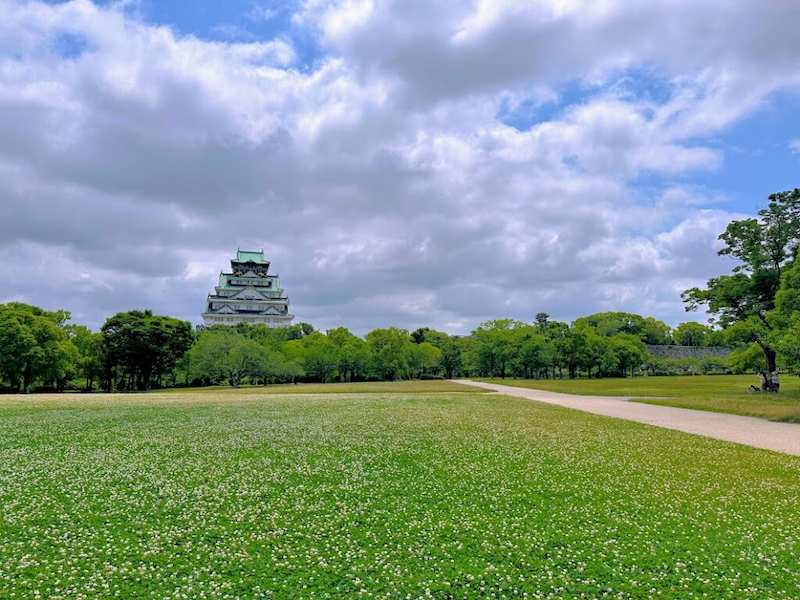
⭐ Recommendation Rating
- Historical Significance: ☆☆☆
- Visual Appeal: ☆☆
- Experiential Value: ☆☆☆
🏛 Overview
Nishinomaru Garden at Osaka Castle is a site of profound historical significance. Once home to the palace residence of Kita-no-Mandokoro (Nene), the lawful wife of the famed warlord Toyotomi Hideyoshi, this area continues to echo with memories of Hideyoshi and his family. Today, it serves as a serene public park spanning approximately 6.5 hectares, offering a spacious lawn surrounded by cherry and plum trees that reflect the changing seasons.
Historically, this location was the site of the Nishinomaru Goten (Nishinomaru Palace). During the early years of Toyotomi Hideyori—Hideyoshi’s son—when he still lacked political experience, Nene retired from the Ninomaru Palace, allowing Tokugawa Ieyasu to reside at Nishinomaru and effectively oversee political affairs. In this way, Nishinomaru played a pivotal role during the transitional period from the Toyotomi regime to Tokugawa rule, serving as a vital political stage during one of Japan’s most transformative eras.
The garden as we know it today was developed in 1969 (Showa 44), and unlike the more bustling Ninomaru area, it is cherished for its quiet, calming atmosphere. It is renowned across Japan as a premier cherry blossom viewing spot, with around 300 Somei Yoshino cherry trees blooming simultaneously—a truly breathtaking sight with Osaka Castle’s main keep as a dramatic backdrop.
Within the garden, visitors can also explore several Important Cultural Properties, including the Inui-yagura, Sengan-yagura, and Tamon-yagura turrets. These historical structures date back to the Tokugawa shogunate’s reconstruction of Osaka Castle during the Genna to Kan’ei periods and remain remarkably well-preserved.
Adding to the garden’s unique character is the Osaka Guest House (formerly the Kii-no-Miya Residence), built to commemorate the wedding of Emperor Showa. This rare combination of Showa-era elegance and Sengoku-period architecture creates a truly exceptional cultural space where two distinct periods in Japanese history beautifully converge.
| Year Built | Established in the 1960s |
|---|---|
| Builder | Osaka City Government |
| Structure/Features | 6.5-hectare lawn garden with approximately 300 cherry trees, tea house (Toyoshoan), Osaka State Guest House, and Enshogura (gunpowder storehouse) |
| Renovation/Restoration | Developed into a public garden in the 1960s; Osaka State Guest House constructed in 1995 |
| Current Status | Open to the public as a paid-entry garden; popular cherry blossom viewing spot |
| Destruction/Damage | Original structures destroyed during the Meiji Restoration; area repurposed in the 20th century |
| Cultural Property Designation | Enshogura designated as an Important Cultural Property |
| Remarks | Former site of Kita no Mandokoro’s residence; offers scenic views of Osaka Castle’s main tower |
🗺 Address:
Osaka Castle 2, Chuo-ku, Osaka City, Osaka Prefecture (Nishinomaru area within Osaka Castle Park)
🚶 Access
2 minutes on foot (approx. 120m) from Sengan Yagura
⏳ Estimated tour
time: Short tour: About 30-40 minutes.
If you want to explore the area thoroughly: About 1-1.5 hours (including the turret and guest house)
📍 Attractions
🔹 Lawn Plaza with Castle Tower View:
A wide open lawn offering a picture-perfect view of Osaka Castle’s main tower. In spring, the cherry blossoms create a pink tunnel along the pathways—making it one of the best photo spots in the park.
🔹 Important Cultural Properties:
The Inui, Sengan, and Tamon Turrets stand side by side, showcasing the military design of early Edo-period castles. Visitors can get a close-up look at their exterior architecture and understand how they contributed to castle defense.
🔹 Osaka Guest House (former Kii-no-Miya residence):
A rare Showa-period structure that combines traditional Japanese and Western architectural elements. While not always open, visitors may tour the inside during special public events or private reservations.
🔹 Seasonal Highlights:
- Spring: The Nishinomaru Garden Cherry Blossom Festival takes place, with trees lit up at night for a magical atmosphere.
- Autumn: The fall foliage blends beautifully with the historical architecture, creating a peaceful and colorful scene.
📌 Trivia
🔹 Surprising Historical Background:
This area was once home to the Nishinomaru Palace, where Hideyoshi’s wife Nene is said to have spent her final years. During the Edo period, it also served as a shogunal lodging when Tokugawa shoguns traveled to Kyoto.
🔹 Little-Known Fact:
Many engraved stones (kokuinseki) remain in the garden’s stone walls. These stones bear marks of feudal domains and stonemasons, offering a glimpse into the labor and logistics behind Osaka Castle’s construction—details that castle fans will love.
🔹 Connection with Famous People:
When Tokugawa shoguns traveled west, they often stayed in Nishinomaru as a temporary palace. Historical records show that Tokugawa Iemitsu and Tokugawa Yoshimune conducted government affairs here. After the Meiji Restoration, the grounds were also used as an imperial guest house, bridging feudal and modern eras.
Hitsujisaru Yagura Remains
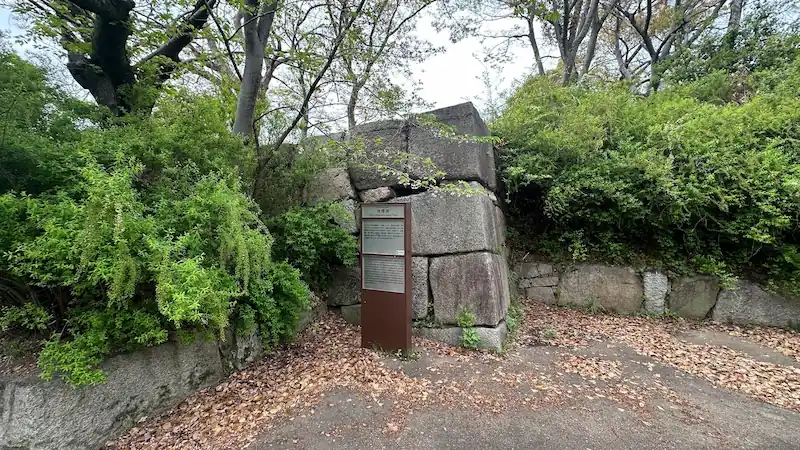
⭐ Recommendation Rating
- Historical Significance: ☆☆
- Visual Appeal: ☆
- Experiential Value: ☆
🏛 Overview
The HitsujisaruYagura Remains mark the former location of a corner turret once built in the southwest corner of the Ninomaru area of Osaka Castle. In Japanese castle terminology, “Hitsujisaru” (坤) refers to the southwest direction, and this Yagura was responsible for defending that critical area of the castle.
Believed to have been constructed in the early 1620s during the Tokugawa Shogunate’s large-scale reconstruction of Osaka Castle, the two-story structure measured approximately eight bays east–west and seven bays north–south, making it nearly the same size as the still-standing Sengan Yagura. With 25 strategically placed windows, primarily on the south and west sides, the Yagura was clearly designed for maximum visibility and defense.
Although it survived the fires of the Meiji Restoration, it was unfortunately destroyed during an air raid in World War II. Today, only the stone base remains—but even this quiet ruin speaks volumes about its past significance.
| Year Built | Early 1620s (Edo period) |
|---|---|
| Builder | Tokugawa Shogunate |
| Structure/Features | Two-story corner turret with 25 defensive windows; stone base remains |
| Renovation/Restoration | None; destroyed during WWII, only stone foundation remains |
| Current Status | Stone base intact; turret no longer exists |
| Destruction/Damage | Destroyed in World War II air raids |
| Cultural Property Designation | None |
| Remarks | Located in the southwest corner of Ninomaru; symbolically guarded the vulnerable “Hitsujisaru” (southwest) direction |
🗺 Address:
1-1 Osaka Castle, Chuo-ku, Osaka City, Osaka Prefecture (Southwest corner of Ninomaru)
🚶 Access
2 minutes on foot (approx. 130m) from Nishinomaru Garden
⏳ Estimated tour
time: Short tour: About 5 to 10 minutes
. If you want to explore thoroughly: About 20 to 30 minutes (including visiting the remains of Minamishikirimon Gate and Sengan-yagura Tower).
📍 Attractions
🔹 Remaining Stone Base:
Although the Yagura itself is gone, the original stone base remains in good condition. Standing close, you can admire the craftsmanship and precision of Edo-period stonemasons.
🔹 Estimated Scale:
Historical records suggest the Hitsujisaru Yagura was comparable in size to the Sengan Yagura, reflecting the importance placed on defending the castle’s southwest side. Its large footprint and multi-windowed design highlight its military role.
🔹 Symbolic Direction:
“Hitsujisaru” (the Sheep-Monkey direction) refers to southwest, which in Feng Shui is associated with vulnerability. As such, the placement of the Yagura here carried both military and spiritual significance in the castle’s design.
🔹 Seasonal Highlights:
In spring, cherry blossoms bloom just beyond the remaining stone walls, allowing visitors to imagine the long-lost turret amidst the falling petals. In autumn, the textured stones are softly highlighted by the warm tones of the changing leaves, offering a peaceful and contemplative scene.
📌 Trivia
🔹 Surprising Historical Background:
Although many buildings were lost during the Meiji Restoration, the Hitsujisaru Yagura survived for a time and may have even been repurposed as a military facility. Some documentation supports its use by the early modern army.
🔹 Little-Known Detail:
Kokuinseki (engraved stones) can still be found in the Yagura’s stone base—these stonemason marks act like ancient “signatures,” revealing the identities of those who built it.
🔹 Connection to Historical Figures:
The Hitsujisaru Yagura was part of the Tokugawa Shogunate’s post-Siege reconstruction, led by Tokugawa Hidetada. As such, it stands as a symbolic remnant of the early Edo period’s military ambitions and centralized power.
Inui Yagura

⭐ Recommendation Rating
- Historical Significance: ☆☆☆
- Visual Appeal: ☆☆☆
- Experiential Value: ☆☆☆
🏛 Overview
Inui Yagura is a prominent corner turret located at the northwest corner of Nishinomaru in Osaka Castle. The name “Inui” (乾) refers to the northwest direction, following the traditional Japanese compass based on the twelve zodiac signs. This turret was one of the castle’s most important defensive strongholds, guarding a direction considered crucial both strategically and spiritually.
Built in 1620 during the Tokugawa Shogunate’s major reconstruction of Osaka Castle, the Inui Yagura is one of the oldest surviving structures in the castle complex, along with the Sengan Yagura. Its most notable architectural feature is its rare L-shaped, two-story structure, with both floors having almost equal area. This configuration is extremely uncommon in Japanese castle architecture and reflects a highly sophisticated defensive design.
Although it escaped the fires of war, the Yagura was dismantled and restored in 1959, preserving its original appearance and allowing future generations to appreciate its historical and architectural significance.
| Year Built | 1620 (Edo period) |
|---|---|
| Builder | Tokugawa Shogunate, designed by Kobori Enshū |
| Structure/Features | L-shaped two-story turret with defensive openings; overlooks the northwest corner of the castle |
| Renovation/Restoration | Maintained in original condition; limited restorations over time |
| Current Status | Original structure; designated as an Important Cultural Property |
| Destruction/Damage | Survived multiple conflicts; remains intact |
| Cultural Property Designation | Important Cultural Property (Japan) |
| Remarks | One of the oldest surviving structures in Osaka Castle; occasionally open to the public during special exhibitions |
🗺 Address:
1-1 Osaka Castle, Chuo-ku, Osaka City, Osaka Prefecture (Northwest of Nishinomaru Garden)
🚶 Access
: Approximately 1 minutes on foot (approximately 91m) from Hitsujisaru Yagura Remains
⏳ Estimated tour
time: Short tour: About 15-20 minutes.
If you want to explore thoroughly: About 1 hour (including other ruins in the Nishinomaru Garden).
📍 Attractions
🔹 Unique L-Shaped Design:
The L-shape of Inui Yagura is highly unusual. This form not only maximizes visibility across two sides of the castle but also enhances defensibility through overlapping fields of fire—an advanced feature of military design at the time.
🔹 Two Equal-Size Floors:
Unlike many turrets where the upper floor is smaller, both floors here are nearly identical in size, offering enhanced stability and usability. This symmetry also reflects a sense of balance in Edo-period architecture.
🔹 Comparison with Sengan Yagura:
Built in the same era as the Sengan Yagura, Inui Yagura offers visitors a chance to observe the evolution of turret construction in Osaka Castle. The architectural differences between the two turrets highlight advancements in engineering and military thinking.
🔹 Seasonal Highlights:
In spring, cherry blossoms bloom around Nishinomaru Garden, and the view of Inui Yagura set against the pink blossoms is stunning. In autumn, the setting sun casts a golden glow on the white plaster walls, creating a breathtaking scene of harmony between history and nature.
📌 Trivia
🔹 Surprising Historical Background:
The northwest corner where Inui Yagura stands was believed to be the “Ura Kimon” or “back demon gate”—the spiritual opposite of the northeast “Kimon,” traditionally viewed as an unlucky direction. By placing a strong Yagura here, castle builders were both warding off misfortune and reinforcing military strategy.
🔹 Little-Known Detail:
Inui Yagura showcases fine stonemasonry, with intricately placed cornerstones and angled joints. These techniques speak to the skill of Edo-period craftsmen and are a hidden highlight for fans of historical architecture.
🔹 Connections to Historical Figures:
It is highly likely that Matsudaira Tadaaki, the first castle lord of Osaka under the Tokugawa Shogunate, was directly involved in overseeing the construction of Inui Yagura. His influence can still be felt in the design and strategic placement of the turret.
Enshōgura (Gunpowder Storehouse)
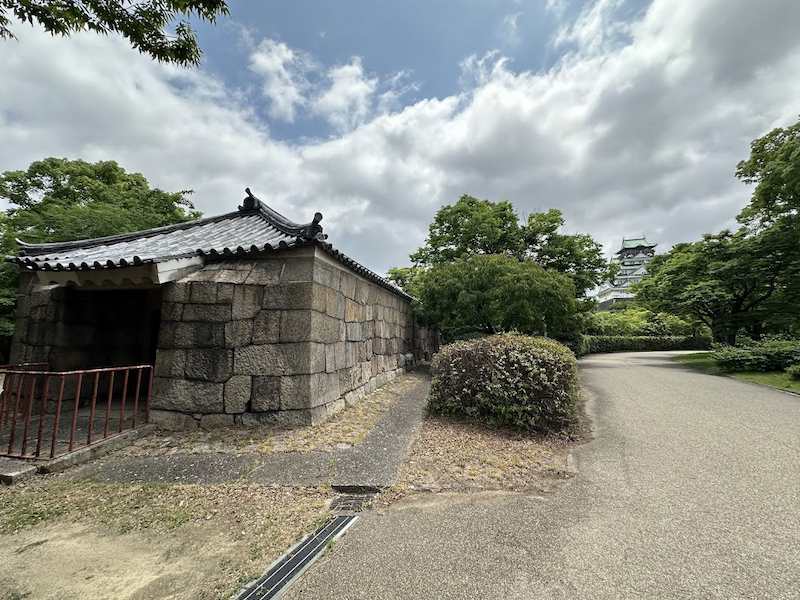
⭐ Recommendation Rating
- Historical Significance: ☆☆☆
- Visual Appeal: ☆☆☆
- Experiential Value: ☆☆
🏛 Overview
The Enshōgura at Osaka Castle is an extremely rare and valuable structure: a gunpowder storehouse built during the Edo period. The name “Enshō” (焔硝) refers to saltpeter, the key ingredient in black powder. This stone building was specifically constructed to store gunpowder safely, making it one of Japan’s most advanced fire- and explosion-resistant facilities of its time.
Every aspect of its architecture reflects this purpose. The walls, floor, and ceiling are made entirely of precisely cut granite, and the gaps between stones are sealed with plaster, creating a completely airtight and flameproof structure. This level of construction made it possible to store explosive materials even in the heart of the castle.
Built in 1685, as confirmed by historical records, the building was dismantled and restored in 1960 to preserve its original form. Although it was constructed after the Toyotomi era, Enshōgura offers insight into Osaka Castle’s transformation from a fortress into a center of administration under Tokugawa rule. It stands today as the only surviving stone gunpowder storehouse in Japan, and is designated as an Important Cultural Property.
| Year Built | 1685 (Edo period) |
|---|---|
| Builder | Tokugawa Shogunate |
| Structure/Features | Stone construction with 2.4-meter-thick granite walls; airtight and fireproof design for gunpowder storage |
| Renovation/Restoration | Dismantled and restored in 1960 to preserve original form |
| Current Status | Original structure; designated as an Important Cultural Property |
| Destruction/Damage | Predecessor exploded in 1660 due to lightning; current structure built to prevent recurrence |
| Cultural Property Designation | Important Cultural Property (Japan) |
| Remarks | Only surviving stone gunpowder storehouse in Japan; showcases advanced Edo-period engineering |
🗺 Address:
1-1 Osaka Castle, Chuo-ku, Osaka City, Osaka Prefecture (near Sengan-yagura and Tamon-yagura)
🚶 Access
2 minutes on foot (approx. 190m) from Inui Yagura
⏳ Estimated tour
time: Short tour: About 10-15 minutes
. If you want to explore the area thoroughly: About 30-40 minutes (including visiting the nearby Sengan-yagura and Tamon-yagura turrets).
📍 Attractions
🔹 All-Stone Structure:
The building is constructed entirely of granite blocks, with no wooden components, to prevent fire or accidental explosions. The joints are filled with thick plaster for airtight sealing, a cutting-edge safety feature in its time.
🔹 Japan’s Only Surviving Edo-Era Gunpowder Storehouse:
Unlike many similar facilities that have been lost to fire or war, Enshōgura survives in remarkable condition, giving it great historical and architectural value.
🔹 Military Centerpiece:
Its proximity to Sengan Yagura and Tamon Yagura shows that this area functioned as a military operations hub, where weapons and gunpowder were centrally managed.
🔹 Seasonal Highlights:
In spring, pale cherry blossoms bloom around the stark stone walls, creating a dramatic visual contrast. In autumn, the subdued granite surfaces blend with golden foliage, evoking a tranquil, reflective mood.
📌 Trivia
🔹 Surprising Historical Background:
To minimize risks, the gunpowder was stored in a secluded section of the castle, far from residences and administrative buildings. The storehouse was designed not only to resist external threats but also to contain any internal accidents.
🔹 Little-Known Detail:
Although the interior is not open to the public, the plaster between the stones was specially formulated to absorb moisture and maintain stable temperature and humidity—ideal conditions for preserving volatile substances.
🔹 Connection to Historical Figures:
Enshōgura was constructed during the Jōkyō era (1684–1688), under Shogun Tokugawa Tsunayoshi, who is also known for his Edict for the Compassionate Treatment of Living Things. While his governance focused on peace, this structure is a reminder that military infrastructure remained crucial even in times of relative stability.
Sixth Tower
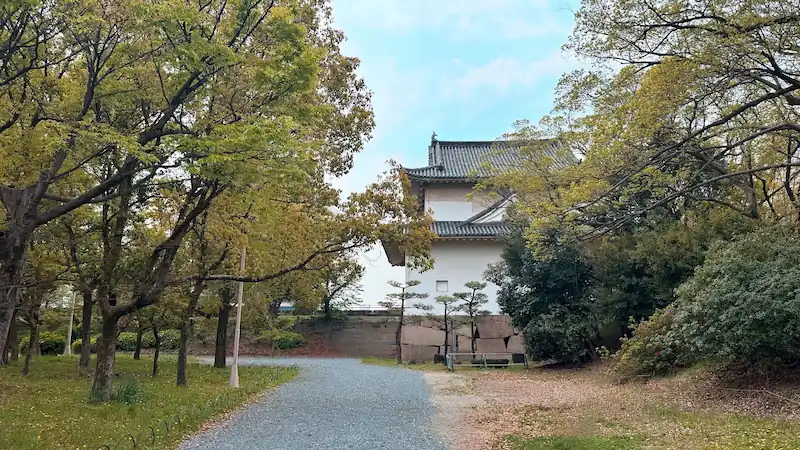
Photo from the outer moat
⭐ Recommendation Rating
- Historical Significance: ☆☆☆
- Visual Appeal: ☆☆
- Experiential Value: ☆☆
🏛 Overview
Rokuban Yagura, or the Sixth Turret, is one of only two surviving turrets out of the original seven that once lined the southern outer moat on the south side of Osaka Castle’s Ninomaru area. The other remaining turret is Ichiban Yagura (First Turret). Due to their rarity, both structures are considered of high cultural and historical value.
Rokuban Yagura was built in 1628, during the later phase of the Tokugawa Shogunate’s reconstruction of Osaka Castle. Compared to earlier turrets like Sengan Yagura and Inui Yagura, this structure exhibits an evolution in both architectural style and construction techniques. Notable elements include its refined roof curvature, enhanced wall design, and improved stone masonry—all indicative of the more sophisticated aesthetic and engineering standards of the late Edo period.
Having survived wars and natural disasters, the turret was dismantled and restored in 1966, allowing it to retain much of its original character. Today, Rokuban Yagura not only serves as a remnant of the castle’s defensive network, but also as a valuable piece of historical architecture from the final era of feudal Japan.
| Year Built | 1628 (Edo period) |
|---|---|
| Builder | Tokugawa Shogunate |
| Structure/Features | Two-story turret with curved rooflines and stylized wall designs; part of a seven-turret defense line along the southern outer moat |
| Renovation/Restoration | Restored after damage from WWII bombing raids and a typhoon in 1950 |
| Current Status | One of only two surviving turrets from the original seven; designated as an Important Cultural Property |
| Destruction/Damage | Heavily damaged by U.S. bombing in 1945 and a typhoon in 1950 |
| Cultural Property Designation | Important Cultural Property (Japan) |
| Remarks | Located on the southern outer moat of the Ninomaru area; showcases a blend of military function and aesthetic appeal |
🗺 Address:
1-1 Osaka Castle, Chuo-ku, Osaka City, Osaka Prefecture (Southwest of Ninomaru)
🚶 Access
: Approximately 7 minutes on foot (approximately 550m) from Enshōgura (Gunpowder Storehouse)
⏳ Estimated tour
time: Short tour: About 10-15 minutes
. If you want to explore the area thoroughly: About 30-40 minutes (including the First Tower and the South Outer Moat)
📍 Attractions
🔹 Strategic Location on the Southern Outer Moat
Rokuban Yagura once formed part of a seven-turret defense line, protecting the vulnerable southern edge of the castle. Its positioning was key to overseeing approaches from the south.
🔹 Architectural Refinement
Unlike the more utilitarian turrets from the early Edo period, the Sixth Turret showcases refined details, such as gracefully curved rooflines and stylized wall designs, representing a fusion of military function and aesthetic appeal.
🔹 Stone Wall Integration
The turret rests atop a high stone foundation, built with precise stonemasonry techniques that were developed during the Tokugawa era. The arrangement and markings on the stones highlight the craftsmanship of the period.
🔹 Seasonal Beauty
In spring, cherry blossoms bloom along the moat, creating a stunning contrast with the white walls of the turret. In autumn, the soft light and colored foliage bring out the texture of the stonework and plaster, making it a favorite spot for photographers.
📌 Trivia
🔹 Surprising Historical Background
The seven turrets along this section of the castle were managed by number, not by construction order. Rokuban Yagura served as the “final defense point on the southern front,” playing a crucial role in the overall defensive plan.
🔹 Little-Known Detail
Rokuban Yagura features a chidori hafu—a triangular gable roof decoration—on its top, blending practicality from the Warring States era with ornamental sophistication of the Edo period.
🔹 Connection to Historical Figures
The turret was completed during the reign of Tokugawa Iemitsu, the third shogun of the Tokugawa dynasty. It reflects Iemitsu’s vision for enhanced castle defense and his desire to solidify Tokugawa authority through imposing architecture.
Toyokuni Shrine

⭐ Recommendation Rating
- Historical Significance: ☆☆
- Visual Appeal: ☆☆
- Experiential Value: ☆☆☆
🏛 Overview
Toyokuni Shrine, located within Osaka Castle Park, is dedicated to Toyotomi Hideyoshi, one of Japan’s most influential historical figures. Established in the early Meiji period, the shrine honors Hideyoshi’s monumental achievements in unifying Japan, ending centuries of civil war, and promoting cultural and economic development.
The original Toyokuni Shrine, once located inside the Honmaru (main citadel) of Osaka Castle, was destroyed during wartime. The current structure was rebuilt and relocated in 1961, and a striking bronze statue of Hideyoshi now stands proudly on the shrine grounds. Dressed in a military coat (jinbaori) with a war fan at his side, the statue captures the aura and leadership of this legendary Sengoku-era warlord.
As Osaka is deeply connected to Hideyoshi’s legacy, the shrine has become a spiritual landmark and a popular power spot, especially among business professionals seeking success, promotions, and new ventures.
| Year Built | 1879 (Meiji period) |
|---|---|
| Builder | Commissioned by Emperor Meiji |
| Structure/Features | Shinto shrine with large torii gates, bronze statue of Toyotomi Hideyoshi, and Shuseki-tei stone garden |
| Renovation/Restoration | Relocated to current location within Osaka Castle Park in 1961 |
| Current Status | Active shrine; site for worship and cultural events |
| Destruction/Damage | Original shrine in Nakanoshima dismantled; current structure relocated and preserved |
| Cultural Property Designation | Not designated as a cultural property |
| Remarks | Dedicated to Toyotomi Hideyoshi, his son Hideyori, and half-brother Hidenaga; known for career success prayers and seasonal festivals |
🗺 Address:
2-1 Osakajo, Chuo-ku, Osaka City, Osaka Prefecture
🚶 Access
4 minutes on foot (approx. 260m) from Sixth Tower
⏳ Estimated time for sightseeing
: Short tour: About 20-30 minutes.
For a thorough tour: About 45 minutes to 1 hour (including visiting the shrine, bronze statues, and temple seals)
📍 Attractions
🔹 Bronze Statue of Toyotomi Hideyoshi
Standing at approximately 5.2 meters tall, the statue exudes strength and dignity. With his stern gaze and military attire, Hideyoshi appears ready to lead even in spirit—making it a powerful photo spot and a symbol of ambition.
🔹 Main Shrine Building & Office
A serene wooden structure where you can purchase protective charms, ema (wish plaques), and goshuin (temple stamps). Prayers for career advancement, luck in exams, prosperity, and health are popular among visitors.
🔹 Seasonal Scenery
In spring, cherry blossoms frame the shrine and the statue in soft pink. In autumn, golden foliage brings a dignified calm to the grounds, blending beautifully with the shrine’s historical aura.
🔹 Ways to Enjoy by Season
During spring, many visitors photograph Hideyoshi’s statue against a backdrop of blooming cherry trees. Autumn’s golden leaves offer a more tranquil experience, perfect for peaceful walks and reflection.
📌 Trivia
🔹 Surprising Historical Background
Toyokuni Shrines were founded across Japan during the Meiji period as part of a national effort to deify Hideyoshi and promote him as a heroic figure. Among these, Osaka’s Toyokuni Shrine holds the most historical and symbolic weight due to the city’s ties to Hideyoshi.
🔹 Little-Known Detail
The Shinji Pond, located on the southern side of the shrine grounds, is believed to be a remnant of the original Osaka Castle gardens. Its still waters reflect the long passage of time and the legacy left behind.
🔹 Connection to Famous People
The shrine’s establishment was influenced by Yamagata Aritomo, a prominent Meiji statesman. His support reflects how Hideyoshi’s legacy remained respected even in modern political and cultural thought.
Ichiban Yagura (First Turret)
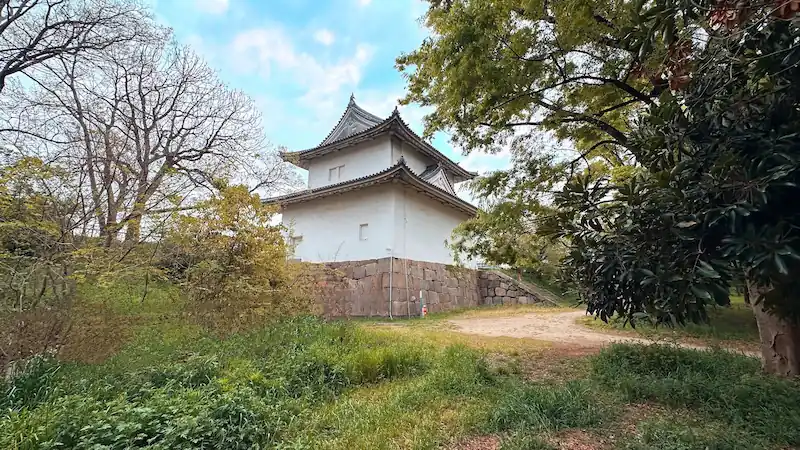
⭐ Recommendation Rating
- Historical Significance: ☆☆☆
- Visual Appeal: ☆☆
- Experiential Value: ☆
Ichiban Yagura, or the First Turret, is located at the southeastern edge of the Ninomaru area of Osaka Castle. It was named not according to the order of construction, but rather its easternmost position among the original seven turrets lining the southern outer moat. It played a strategic role as a flanking defense point for the nearby Tamatsukuriguchi Gate.
While the exact date of its original construction is unclear, the turret underwent major renovations in 1668, resulting in the form we see today. It was later dismantled and restored in 1965, and now stands as a representative example of late Edo-period military architecture—bridging the shift from purely functional Sengoku-style fortifications to more visually commanding designs of the early modern era.
| Year Built | 1628 (Edo period) |
|---|---|
| Builder | Tokugawa Shogunate; construction overseen by the Kinoshita clan |
| Structure/Features | Two-story corner turret with white plaster walls, tiled roof, and defensive features such as arrow slits and stone drop windows |
| Renovation/Restoration | Major repairs in 1668, 1832, and post-WWII restoration after partial fire damage |
| Current Status | Original structure; designated as an Important Cultural Property |
| Destruction/Damage | Partially damaged during the 1945 air raids; restored post-war |
| Cultural Property Designation | Important Cultural Property (Japan) |
| Remarks | One of only two surviving numbered turrets along the southern outer moat; strategically positioned to defend Tamatsukuri Gate |
🗺 Address:
1-1 Osaka Castle, Chuo-ku, Osaka City, Osaka Prefecture (Southeast end of Ninomaru)
🚶 Access
: Approximately 2 minutes on foot (approximately 190m) from Toyokuni Shrine
⏳ Estimated tour
time: Short tour: About 10 to 15 minutes.
If you want to take your time sightseeing: About 30 minutes (including the Rokuban Yagura and Tamazukuri Gate ruins)
📍 Highlights
🔹 Strategic Flanking Function
Ichiban Yagura overlooks the approach to Tamatsukuriguchi Gate, making it a key lookout and sniper point for defending the southern entrance to the castle.
🔹 Mid-Edo Period Design Features
The roof and wall styles reflect architectural trends from the Kanbun era (1660s), when castle structures began to emphasize symbolism and prestige in addition to functionality. The turret demonstrates a fusion of Sengoku practicality and Edo aesthetics.
🔹 Position and Viewpoint
Built at an angle to oversee the southern moat and surrounding path, the turret provided both surveillance and defense, giving visitors a sense of strategic design.
🔹 Seasonal Experiences
In spring, the turret stands out dramatically against rows of cherry blossoms along the moat—making it a popular photo spot. In autumn, the contrast between the red foliage and the turret’s white walls creates a serene and reflective atmosphere.
📌 Trivia
🔹 Surprising Historical Background
Despite its name, “Ichiban Yagura” (First Turret) refers to its position—not the construction order. This suggests that the east side was viewed as the most critical for early threat detection, reflecting contemporary military strategy.
🔹 Little-Known Fact
The stone base of the turret still bears the marks of individual stonemasons, offering insight into the craftsmanship and organization of labor during the Edo period.
🔹 Connection to Famous People
The nearby Tamatsukuriguchi Gate was part of the Honmachi-suji, the main road into the castle. As such, daimyo (feudal lords) would have passed by Ichiban Yagura when visiting Osaka Castle, making it a key visual symbol of authority and prestige.




comment